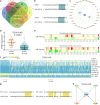Expression profile of SYNE3 and bioinformatic analysis of its prognostic value and functions in tumors
- PMID: 32948197
- PMCID: PMC7501639
- DOI: 10.1186/s12967-020-02521-7
Expression profile of SYNE3 and bioinformatic analysis of its prognostic value and functions in tumors
Abstract
Background: Spectrin repeat containing nuclear envelope family member 3 (SYNE3) encodes an essential component of the linker of the cytoskeleton and nucleoskeleton (LINC) complex, namely nesprin-3. In a tumor, invasiveness and metastasis rely on the integrity of the LINC complex, while the role of SYNE3/nesprin-3 in cancer is rarely studied.
Methods: Here, we explored the expression pattern, prognostic value, and related mechanisms of SYNE3 through both experimental and bioinformatic methods. We first detected SYNE3 in BALB/c mice, normal human tissues, and the paired tumor tissues, then used bioinformatics databases to verify our results. We further analyzed the prognostic value of SYNE3. Next, we predicted miRNA targeting SYNE3 and built a competing endogenous RNA (ceRNA) network and a transcriptional network by analyzing data from the cancer genome atlas (TCGA) database. Interacting genes of SYNE3 were predicted, and we further performed GO and KEGG enrichment analysis on these genes. Besides, the relationship between SYNE3 and immune infiltration was also investigated.
Results: SYNE3 exhibited various expressions in different tissues, mainly located on nuclear and in cytoplasm sometimes. SYNE3 expression level had prognostic value in tumors, possibly by stabilizing nucleus, promoting tumor cells apoptosis, and altering tumor microenvironment. Additionally, we constructed a RP11-2B6.2-miR-149-5p-/RP11-67L2.2-miR-330-3p-SYNE3 ceRNA network and a SATB1-miR-149-5p-SYNE3 transcriptional network in lung adenocarcinoma to support the tumor-suppressing role of SYNE3.
Conclusions: Our study explored novel anti-tumor functions and mechanisms of SYNE3, which might be useful for future cancer therapy.
Keywords: Bioinformatic analysis; CeRNA network; Expression profile; Immune infiltration; SYNE3; Tumor.
Conflict of interest statement
The authors declare no competing interests.
Figures






Similar articles
-
Expression and clinical significance of SYNE3 in non-small cell lung cancer.Am J Transl Res. 2024 Sep 15;16(9):4436-4449. doi: 10.62347/ZHBP7145. eCollection 2024. Am J Transl Res. 2024. PMID: 39398556 Free PMC article.
-
Integrative Analysis of Three Novel Competing Endogenous RNA Biomarkers with a Prognostic Value in Lung Adenocarcinoma.Biomed Res Int. 2020 Aug 4;2020:2837906. doi: 10.1155/2020/2837906. eCollection 2020. Biomed Res Int. 2020. PMID: 32802839 Free PMC article.
-
Expression profile and bioinformatics analysis of COMMD10 in BALB/C mice and human.Cancer Gene Ther. 2020 Apr;27(3-4):216-225. doi: 10.1038/s41417-019-0087-9. Epub 2019 Feb 21. Cancer Gene Ther. 2020. PMID: 30787448
-
Comprehensive Analysis of Competing Endogenous RNA (ceRNA) Network Based on RNAs Differentially Expressed in Lung Adenocarcinoma Using The Cancer Genome Atlas (TCGA) Database.Med Sci Monit. 2020 Jun 13;26:e922676. doi: 10.12659/MSM.922676. Med Sci Monit. 2020. PMID: 32533823 Free PMC article.
-
Using biological information to analyze potential miRNA-mRNA regulatory networks in the plasma of patients with non-small cell lung cancer.BMC Cancer. 2022 Mar 21;22(1):299. doi: 10.1186/s12885-022-09281-1. BMC Cancer. 2022. PMID: 35313857 Free PMC article.
Cited by
-
WT1 Inhibits Human Renal Carcinoma Cell Proliferation and Induces G2/M Arrest by Upregulating IL-24 Expression.Biomed Res Int. 2022 Jul 23;2022:1093945. doi: 10.1155/2022/1093945. eCollection 2022. Biomed Res Int. 2022. PMID: 35915803 Free PMC article.
-
SYNE1 Mutation Is Associated with Increased Tumor Mutation Burden and Immune Cell Infiltration in Ovarian Cancer.Int J Mol Sci. 2023 Sep 18;24(18):14212. doi: 10.3390/ijms241814212. Int J Mol Sci. 2023. PMID: 37762518 Free PMC article.
-
Lnc-AIFM2-1 promotes HBV immune escape by acting as a ceRNA for miR-330-3p to regulate CD244 expression.Front Immunol. 2023 Feb 9;14:1121795. doi: 10.3389/fimmu.2023.1121795. eCollection 2023. Front Immunol. 2023. PMID: 36845111 Free PMC article.
-
Expression and clinical significance of SYNE3 in non-small cell lung cancer.Am J Transl Res. 2024 Sep 15;16(9):4436-4449. doi: 10.62347/ZHBP7145. eCollection 2024. Am J Transl Res. 2024. PMID: 39398556 Free PMC article.
-
Genomic Structure and Molecular Characterization of Toll-like Receptors in Black Scraper Thamnaconus Modestus and Their Expression Response to Two Types of Pathogens.Mar Biotechnol (NY). 2023 Oct;25(5):800-814. doi: 10.1007/s10126-023-10241-4. Epub 2023 Aug 11. Mar Biotechnol (NY). 2023. PMID: 37566262
References
-
- Abdel Ghafar MT, Gharib F, Abdel-Salam S, Elkhouly RA, Elshora A, Shalaby KH, et al. Role of serum Metadherin mRNA expression in the diagnosis and prediction of survival in patients with colorectal cancer. Mol Biol Rep. 2020;4(47):2509–2519. - PubMed
-
- Ghafar MTA, Gharib F, Al-Ashmawy GM, Mariah RA. Serum high-temperature-required protein A2: a potential biomarker for the diagnosis of breast cancer. Gene Rep. 2020;20:100706.
-
- El-Guindy DM, Wasfy RE, Abdel Ghafar MT, Ali DA, Elkady AM. Oct4 expression in gastric carcinoma: association with tumor proliferation, angiogenesis and survival. 2019;1(31):3. - PubMed
-
- Tusamda Wakhloo N, Anders S, Badique F, Eichhorn M, Brigaud I, Petithory T, et al. Actomyosin, vimentin and LINC complex pull on osteosarcoma nuclei to deform on micropillar topography. Biomaterials. 2020;234:119746. - PubMed
Publication types
MeSH terms
Substances
LinkOut - more resources
Full Text Sources
Medical
Molecular Biology Databases

